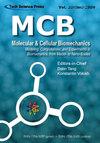男子羽毛球单腿落地动作双腿生物力学比较研究
Q4 Biochemistry, Genetics and Molecular Biology
引用次数: 0
摘要
本研究旨在分析男子羽毛球运动员单腿着地时两腿的生物力学差异,从而为预防运动损伤提供一定的指导。选取10名男子羽毛球运动员作为研究对象。他们成功地做了三次单腿着地动作。运动学数据由Vicon红外高速运动捕捉系统获取。动力学数据由KISTLER三维力测量平台获得。对数据进行了处理和分析。右腿X、Y轴重心分别为0.25±0.05、0.21±0.04 m,均低于左腿(p < 0.05)。单腿着地时,左右腿髋关节角度分别为164.78±6.12°和156.29±6.89°(p < 0.05),左右腿髋关节速度分别为2.21±0.32和1.98±0.31 m/s (p < 0.05),左右腿膝关节速度分别为2.51±0.21和2.21±0.21 m/s (p < 0.05)。虽然在关节活动范围上没有明显差异,但右腿的活动范围大于左腿,右腿膝关节的缓冲时间也明显小于左腿。动力学数据对比发现,右腿的地面反力(GRF)、垂直地面反力峰值(PVGRF)和下肢刚度均显著小于左腿,且力峰值时间大于左腿(p < 0.05)。当运动员单腿着地时,左腿受伤的风险大于右腿。在训练过程中,运动员应加强两条腿尤其是左腿的稳定性训练,以减少运动损伤。本文章由计算机程序翻译,如有差异,请以英文原文为准。
Comparative Study on Biomechanics of Two Legs in the Action of Single-Leg Landing in Men’s Badminton
This study aims to analyze the biomechanical difference between the two legs of male badminton players when they land on one leg, thereby providing some guidance for preventing sports injury. Ten male badminton players were selected as the subjects. They did the single-leg landing movement successfully three times. The kinematic data were obtained by the Vicon infrared high-speed motion capture system. The kinetic data were obtained by the KISTLER three-dimensional forcing measuring platform. The data were processed and analyzed. The center of gravity of the right leg on the X and Y axes were 0.25 ± 0.05 and 0.21 ± 0.04 m, respectively, which were lower than that of the left leg (p < 0.05). At the moment of landing by a single leg, the hip angle of the left and right legs was 164.78 ± 6.12° and 156.29 ± 6.89°, respectively (p < 0.05), the hip joint speed of the left and right legs was 2.21 ± 0.32 and 1.98 ± 0.31 m/s, respectively (p < 0.05), the knee joint speed of the left and right legs was 2.51 ± 0.21 and 2.21 ± 0.21 m/s, respectively (p < 0.05). Although there was no significant difference in the range of joint motion, the motion range of the right leg was larger than that of the left leg, and the buffering time of the knee joint of the right leg was also significantly less than that of the left leg. The comparison of the kinetic data demonstrated that the ground reaction force (GRF), peak vertical ground reaction force (PVGRF), and lower limb stiffness of the right leg were significantly smaller than those of the left leg, and the time to peak force was greater than that of the left leg (p < 0.05). The injury risk of the left leg is greater than that of the right leg when the athlete land on a single leg. In the process of training, the athlete should strengthen the stability training of two legs, especially the left leg, in order to reduce sports injury.
求助全文
通过发布文献求助,成功后即可免费获取论文全文。
去求助
来源期刊

Molecular & Cellular Biomechanics
CELL BIOLOGYENGINEERING, BIOMEDICAL&-ENGINEERING, BIOMEDICAL
CiteScore
1.70
自引率
0.00%
发文量
21
期刊介绍:
The field of biomechanics concerns with motion, deformation, and forces in biological systems. With the explosive progress in molecular biology, genomic engineering, bioimaging, and nanotechnology, there will be an ever-increasing generation of knowledge and information concerning the mechanobiology of genes, proteins, cells, tissues, and organs. Such information will bring new diagnostic tools, new therapeutic approaches, and new knowledge on ourselves and our interactions with our environment. It becomes apparent that biomechanics focusing on molecules, cells as well as tissues and organs is an important aspect of modern biomedical sciences. The aims of this journal are to facilitate the studies of the mechanics of biomolecules (including proteins, genes, cytoskeletons, etc.), cells (and their interactions with extracellular matrix), tissues and organs, the development of relevant advanced mathematical methods, and the discovery of biological secrets. As science concerns only with relative truth, we seek ideas that are state-of-the-art, which may be controversial, but stimulate and promote new ideas, new techniques, and new applications.
 求助内容:
求助内容: 应助结果提醒方式:
应助结果提醒方式:


